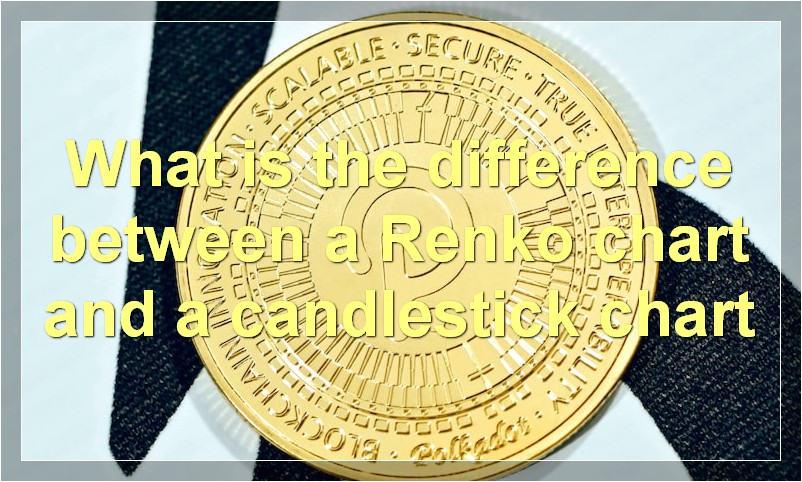In the world of technical analysis, there are many different ways to chart price action. Two of the most popular methods are candlestick charts and Renko charts. While both types of charts can provide valuable information about market trends, they each have their own advantages and disadvantages. In this article, we will take a closer look at the key differences between these two charting methods.
What is the difference between a Renko chart and a candlestick chart

There are two main types of charts that technical analysts use to track price movements in the market: candlestick charts and Renko charts. Both of these charting methods have their own advantages and disadvantages, so it is important to understand the difference between the two before choosing which one to use.
Candlestick charts are the more traditional of the two charting methods, and they provide a clear picture of price action over time. Each candlestick on the chart represents the price movement for a specific time period, such as one day or one hour. The candlesticks are color-coded to show whether the price went up or down during that time period, and the thickness of the candlestick body indicates the size of the price move.
Renko charts are a newer type of charting method that eliminates much of the “noise” created by small price fluctuations. Rather than plotting every price movement like a candlestick chart does, Renko charts only plot price changes that are above a certain threshold. This makes it easier to identify significant price moves, and it can also help filter out false signals.
So, which type of chart is better? That depends on your trading style and what you are looking for in a charting method. If you prefer a more traditional approach, then candlestick charts may be a better choice for you. However, if you want to simplify your analysis and focus on major price moves, then Renko charts may be a better option.
How are Renko bars created
Renko bars are created by using the closing price of a security. A line is drawn from the closing price of the prior period to the closing price of the current period. If the close of the current period is higher than the close of the prior period, a white or green bar is used. If the close of the current period is lower than the close of the prior period, a black or red bar is used. The line is always drawn in the direction of the close, meaning that if two periods have the same closing price, no line is drawn.
How do Renko bars differ from traditional candlesticks
Renko charts are created by placing a brick in the next column once the price surpasses the top or bottom of the previous brick by a pre-determined amount. Traditional candlesticks, on the other hand, are based on the open, high, low, and close of a particular time period.
What is the purpose of using Renko bars
Renko bars are a type of charting used by traders to determine potential support and resistance levels, as well as trend direction. The brick size is set at a fixed price interval, and each new brick is placed on the chart once the price moves beyond the previous brick’s high or low price by the specified interval. If the price moves up by the set interval, a new brick is added above the previous one; if the price moves down by the set interval, a new brick is added below the previous one. This creates a staircase effect on the chart, with each new brick representing a move in price.
The purpose of using Renko bars is to help traders identify potential support and resistance levels, as well as trend direction. By looking at the sequence of bricks, traders can spot when the price is starting to move in a particular direction and look for opportunities to enter or exit trades. Renko bars can also be used in conjunction with other technical indicators to help confirm trading signals.
What are the benefits of using Renko bars

Renko bars are a type of charting used by traders to determine potential support and resistance levels. The benefits of using Renko bars include the ability to more easily identify trends, as well as potential support and resistance levels. Additionally, Renko bars can help to filter out noise, making it easier for traders to focus on the most important price movements.
What are the drawbacks of using Renko bars
There are a few potential drawbacks of using Renko bars when trading. First, because Renko bars only take into account price movement and do not consider time or volume, some traders may feel that they are not as informative as traditional candlestick charts or bar charts. This can make it difficult to make informed trading decisions.
Second, Renko bars can sometimes be too volatile, making it difficult to accurately gauge support and resistance levels. This can lead to poor entry and exit points, and ultimately, losses.
Finally, because Renko bars only consider price movement, they may give false signals in a choppy market. This means that traders need to be extra careful in interpreting Renko charts, or they could end up making poor trades.
How can I use Renko bars to trade better
Renko charts are a type of chart, popular among traders in the financial markets, that displays price information as a series of bricks with no space between them. The size of each brick is determined by price movement. Renko charts can be used to trade better by providing clear and concise information about price movements and trends.
What should I be aware of when trading with Renko bars
When trading with Renko bars, there are a few things you should be aware of. First, because Renko bars are based on price movement, they can be more volatile than other types of charts. This means that your stop-losses and profit targets should be placed accordingly. Secondly, Renko bars can sometimes form what is called a “false breakout.” This occurs when the price breaks out of a previous high or low, only to quickly reverse course. As such, it’s important to wait for a confirmed breakout before entering a trade. Finally, because Renko bars don’t take time into account, they can sometimes give false signals during choppy market conditions. In these cases, it’s often best to wait for the market to calm down before taking a position.
How can I improve my results when trading with Renko bars
When trading with Renko bars, there are a few things you can do to improve your results. First, make sure you have a clear understanding of what Renko bars are and how they work. Second, use a reliable and accurate source for your Renko bars. Third, use a trading strategy that is designed for Renko bars. Fourth, backtest your trading strategy on historical data to ensure that it is effective. Finally, practice your trading strategy on a demo account before implementing it with real money. By following these steps, you can improve your results when trading with Renko bars.

